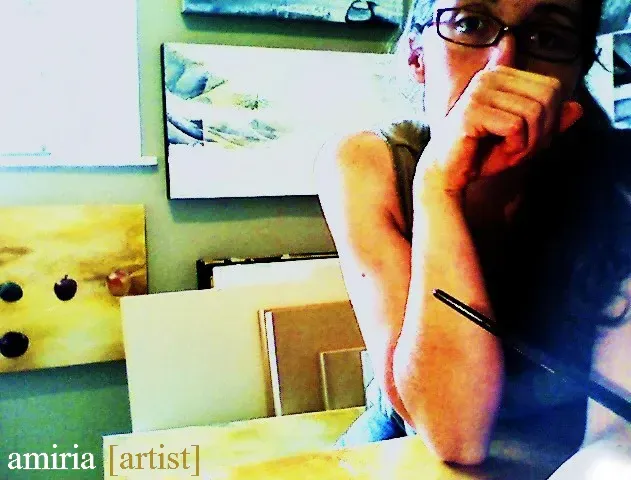Pink Noise: Amiria Gale
Written by

Amiria Gale has recently taken the plunge and left full time employment to pursue a career as an artist. She tells Katie Robinson from Pink Noise her story...
* * *
My childhood was spent in Tolaga Bay, on the East Coast of New Zealand. This was the type of town where you run barefoot: where you live in the sand dunes and feast on crayfish and kina. It is a place where you dive deep under waves with tangled, salt-knotted hair and sunburnt limbs.
It was here, with John Walsh producing his highly realistic Maori portraiture works just down the road, and teachers encouraging me to sit cross-legged on the school grounds and ‘draw what you see’, that I first discovered a love for art-making.
My siblings and I had no shortage of things with which to paint or draw. We had all manner of paints, pencils, crayons and paper. Our mother showed us how to mix colours and apply textures and sometimes sat there herself and drew us lying around her while we watched.
As a teenager, I found great solace in the richly decorated art room walls at Lytton High School. Our classes were bright and vibrant, with many year levels often present at one time in a room. The Art Department had alcoves where senior students worked in undisturbed pockets, while junior students undertook supervised instruction in the centre areas of the rooms. For a shy and reserved teenager, hours of practise had at last begun to culminate in some level of recognisable skill: something I could use with a measure of confidence. At seventeen I had my first commissioned painting, followed by a summer of commissioned artwork (completed while designing and constructing outdoor furniture) sold for pennies to people I knew.
When university called, it was a dramatic change leaving the quiet and unobtrusive East Coast. I attended the Auckland University’s School of Architecture, discovering here, for the first time, how to embrace the true insanity of an artist: how to swallow oneself in work and let it tell a story that speaks more clearly than surface aesthetic ever will. It took me a while to find my feet: a while to learn that someone from a little town in the middle of nowhere could compete with as much fury and ferocity as the next; to learn that artistic endeavour is as much about truth, as the straightness of line or mimicking of shadow.
I finished my degree, and then stood for a moment, utterly lost, toes in the sand, waves furling around my knees.
I turned up, at last, at Auckland College of Education, asking if I could be a teacher. The woman said no. She said I had an architectural background, not an artistic one, and that top schools wouldn’t take me. “I don’t want to teach at that kind of school,” I said, a little stubbornly, and pulled some of my paintings out to show her. The woman looked at them, for a long, careful while. And, quite abruptly, she changed her mind.
So I taught. I have taught five year olds to eighteen year olds, specialising in Painting, managing a secondary art department for seven years at two Auckland schools. Teaching filled my lungs with happiness. It reminded me that, above all, people want to do good. It showed me that achievement is the result of effort, and that I should foster a diligent, systematic approach: temper artistic insanity with process. It was my greatest education. I learnt to how to educate: to convey an exact understanding of that which I speak of.
Teaching kept my brain alive and hungry. It kept creativity sneaking along my veins and an itching in my fingers. The few paintings I made became sought after and accepted by galleries who encouraged me to paint faster and more. But with teaching, as everything, there is a price. It takes practise and finesse to juggle all the components of a busy life, and that juggling act was not one I had yet mastered. I let teaching steal my time.
And so, at thirty years old, I walked away from my students and picked up a paint brush. Finally, instead of an activity that was completed at the edges of an existence, painting was now activity number one. It was that which I fronted up to on a daily basis at 9am, in a paint-stained room with a ripped carpet floor.
I had enough interest in my work prior to leaving teaching to assure me that financial success as an artist was not out of the question. Indeed, I had always been a fervent believer that the biggest reason creative pursuits are perceived to be uneconomically viable is that those with the best chances of success give up before the battle is begun. Many of my most talented students – those who excelled in mathematics and commerce as well as art – never pursued an artistic career, despite being in the best position of all to make it. They let others fill their heads with fear.
I could have felt a similar fear. I could have felt daunted embarking on a career as a full time artist, but instead I felt flooded with joy.
Artists paint to untangle their soul. They paint for the movement of brush; the smear of paint; the feel of texture against skin. They paint for light and shadow and the discovering of what was not there before.
I am amiria [artist]. This is my story.
* * *
To contact Amiria or view her artwork, please visit her Pink Noise Artist Lisitng and her website. Amiria paints East Coast landscapes, broken shells, and obesity / health related artwork. She loves to draw people.
Courtesy of Pink Noise Art Zine #3 / a multi-leveled artist promotional project